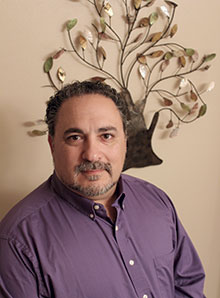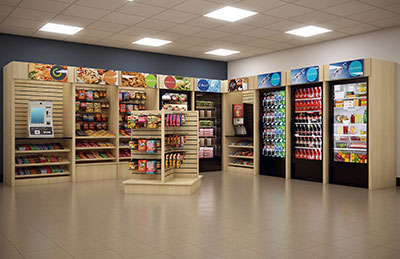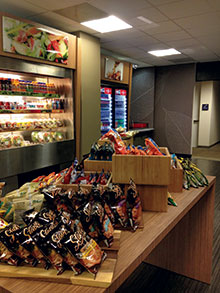Fast-casual concepts seem to dominate the foodservice industry discussion these days, and with good reason. Many of these operators have found the way to meet customers' demands for quality, innovative menu items in a way that resonates with time-strapped customers. This phenomenon is certainly not lost on the world of corporate dining.
 Damian Monticello, Sr. Manager, Hospitality Services, Florida BlueSystem wide at Florida Blue, we have roughly 11,000 employees working from offices in Florida and several states for subsidiaries our company owns. To serve our vast and diverse employee population we operate six cafes, including three on our main campus and two company c-stores. In addition, for some of our smaller sites, those with 300 to 1,000 employees, we operate six micro markets. And we provide vending pretty much on every floor, so we have close to 300 machines throughout our system.
Damian Monticello, Sr. Manager, Hospitality Services, Florida BlueSystem wide at Florida Blue, we have roughly 11,000 employees working from offices in Florida and several states for subsidiaries our company owns. To serve our vast and diverse employee population we operate six cafes, including three on our main campus and two company c-stores. In addition, for some of our smaller sites, those with 300 to 1,000 employees, we operate six micro markets. And we provide vending pretty much on every floor, so we have close to 300 machines throughout our system.
During my 12 years with the company, our foodservice operation had to evolve from what people used to see as a traditional corporate cafeteria into a true restaurant-quality experience. And we had to adopt this approach through multiple points of service.
Our associates can choose from more than 100 restaurants that operate within 5 miles of our main campus. And getting on and off of our campus is pretty easy. We know that people will need to leave campus once in a while to take a break or even run some errands. But for those that want to remain on-site during lunch periods, customer engagement is the key to our success because it enhances the time they spend at work.
For example, we know when people stay on campus for lunch they have opportunities for those impromptu meetings with colleagues that can lead to resolving a challenge while trying to decide what to eat.
Adding value in the form of affordable meals represents another objective for us. We also strive to keep our pricing below area restaurants and other corporate cafeterias to make this experience more affordable for our employees. By studying our employees we know they are back to their desks quicker when they eat on-site and they spend less. And their satisfaction with the taste and overall experience with the meal is pretty high.
As a health solutions company, cultivating a sense of community is a priority for us, too. The largest single group we insure is our own employee base. So being able to impact them from a health and wellness perspective is important.
And we know for some of our employees this might be the best rounded meal they can get during the course of any given day. As a result, we see foodservice functioning as a benefit as much as it is a service.
What does it look like? What does it mean to the physical composition of the dish? We try to make it simple for our employees to understand what that looks like. We can show them how to navigate our cafeteria to meet their health goals, which will reduce the number of trips to the doctor. One way we do this is via a color-coded menu system that takes customers from most healthy to least healthy options. We are not going to be one of those operations that will be completely prescriptive and eliminate some options like burgers and fries because we know they can leave to get them.
 The emergence of micro markets, like the Mechanicsburg, Pa., location seen here, has allowed employers like Florida Blue to reach more of their employees who now have more convenient access to better-for-you food items. And allowing employees to get closer to the food, instead of seeing it only through a vending machine’s pane of glass, makes them more receptive to the experience.As a result, our menus today feature a lot of freshly made dishes and items made to order — all done while taking into account speed and convenience. In other words, we try to emulate fast-casual operations in many respects. Many people don't have time to go to a table service restaurant but they still want quality meals prepared with higher quality, locally sourced ingredients.
The emergence of micro markets, like the Mechanicsburg, Pa., location seen here, has allowed employers like Florida Blue to reach more of their employees who now have more convenient access to better-for-you food items. And allowing employees to get closer to the food, instead of seeing it only through a vending machine’s pane of glass, makes them more receptive to the experience.As a result, our menus today feature a lot of freshly made dishes and items made to order — all done while taking into account speed and convenience. In other words, we try to emulate fast-casual operations in many respects. Many people don't have time to go to a table service restaurant but they still want quality meals prepared with higher quality, locally sourced ingredients.
We feel pretty fortunate that our main campus is in Florida. This gives us year-round access to quality, locally sourced produce. And our proximity to the ocean provides easy access to high quality seafood.
All of these efforts are paying off for us as we have seen a steady growth in participation from our employees. On an average day, we serve 30 percent to 35 percent of our employees during lunch. And when factoring in catering for meetings, we get close to serving 50 percent of our associates.
The emergence of the micro markets has allowed us to reach more of our employees. In the past, we might have only been able to reach them via a vending machine. But the market allows us to help be more supportive in the form of health and wellness. People are more receptive when they are actually able to see the package, touch it and even read the label.
We have taken a look at the commercial foodservice world, examined what our employees were doing, why they were doing it, where they were going, etc. With this information in hand we worked with our partners, including the contract feeders that help run our operations, and tried to craft solutions to keep employees on campus and to make the options affordable.
Grab-and-go is big for us, particularly in our micro markets, where we offer sandwiches and entrée salads. These options are available in our cafeterias, too.
Looking ahead, speed of service will remain a key issue for corporate dining. Everyone is moving at such a fast pace that we will need to cut down the time it takes for them to get their food.
To that end we are incorporating more rapid-cook technology such as quicker panini presses and dual-tech ovens to get the product through. And we are definitely looking at the type of people manning our stations. From a culinary aspect, we want our customers to have a full-service experience while keeping up with the speed everything moves at now.
 Grab-and-go foodservice items are important for corporate dining operators such as Florida Blue. In its Miami café, seen here, the company makes salads, sandwiches and other items available. Employees also have the option to place custom orders at food stations.In addition to our cashless check out options, we are beta testing self-checkout and exploring a web-based ordering system. Also on the horizon is the exploration of a hotel room service-like delivery option. Of course, managing the logistics for such a project can be a challenge given that we have seven buildings on our campus. That's a lot of territory to cover.
Grab-and-go foodservice items are important for corporate dining operators such as Florida Blue. In its Miami café, seen here, the company makes salads, sandwiches and other items available. Employees also have the option to place custom orders at food stations.In addition to our cashless check out options, we are beta testing self-checkout and exploring a web-based ordering system. Also on the horizon is the exploration of a hotel room service-like delivery option. Of course, managing the logistics for such a project can be a challenge given that we have seven buildings on our campus. That's a lot of territory to cover.
Keeping costs in line will forever be a challenge. With commodity prices rising, such as beef and other key ingredients, how do we maintain pricing without sacrificing quality? That's forcing us to look closer at menu composition and other aspects of our operation.
Social responsibility, specifically in the area of energy efficiency is something we are looking at now. Our campus is 17 years old so we are coming to the end of the service life for a variety of equipment items. When we replace specific pieces of equipment, energy efficiency now becomes an important consideration for us. I work very closely with the engineering team that will service and maintain that equipment team to understand their goals, such as waste stream reduction or water reduction, and determine how foodservice can help support them.
Indeed, the expectations of today's consumers are clear and consistent. They want a quality meal at an affordable price produced in a timely manner. And much like our peers that work in restaurants, it's an expectation that we in corporate dining will need to continue to address to remain viable in the eyes of our customers.



